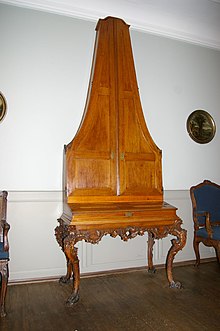Tangent piano

Tangent piano or tangent grand piano are an intermediate form of the clavichord , harpsichord and fortepiano . When a key is pressed, a wooden stick with a leather head is struck against the string from below, a second stick dampens the string again. Tangent wings were built towards the end of the 18th century.
history
Franz Jakob Spath (1714–1786), according to Ernst Ludwig Gerber : “New Historisch-Biographisches Lexikon der Tonkünstler” (Leipzig 1813/14), invented a mechanism for a fortepiano in 1751 in which the sound is not produced by a hammer, as is the case with the fortepiano is generated, but by a wooden strip, the so-called tangent , which is thrown against the string by pressing a button . Späth continued to develop this mechanism until 1770 and built such instruments together with Christoph Friedrich Schmahl (1739–1814) in Regensburg . The designation of this type of construction as a tangent wing can be verified for the first time in 1791. Previously, like the fortepiano, it was simply referred to as a fortepiano or pianoforte.
Wolfgang Amadeus Mozart wrote in a letter dated October 17, 1777: "Before I saw anything of the stone of his work, the late clavier was my favorite", although it remains open whether Mozart meant tangent grand piano by the "late clavier" or other keyboard instruments.
There are still around 20 tangent wings around the world. In 2006, a tangent grand piano in its original state was discovered in the estate of Johann Esaias von Seidel in Sulzbach-Rosenberg . After extensive restoration, it was presented to the public in 2012 as part of a concert by Christoph Hammer and Sylvia Ackermann.
The most important tangent wings that have been preserved are those of Schmahl, his collaborator Johann Wilhelm Berner and of Pastore in Italy.
construction
With the tangent wings, the head of the tangent that strikes the string is unleathered and unfelted wood. The sound is reminiscent of a psaltery or cymbalone struck with bobbins , as used in Hungarian gypsy music. It is a bit silvery, more like a harpsichord, but “with forte and piano”, with dynamic gradations. This sound can be changed by moderator pulls (e.g. by pushing a felt between the string and the tangent, whereby the sound then becomes what we associate it with fortepiano today). In the early fortepianos of the German (and later Viennese) design, the hammer heads were initially also unleathered, and occasionally even reinforced with ivory to prevent wear (e.g. on the pyramid wing by Christian Ernst Friederici from 1745). It was not until 1783 that Johann Andreas Stein began to install leather-covered hammer heads.
Pressing the button (A) lifts its rear end with the pilot (B). The pilot pushes the driver (C) up, which in turn hurls the tangent (D) in a rake against the string (E). At the same time, the damper (F) rises so that the string can vibrate freely.
swell
- Heinrich Herrmann: The Regensburg piano makers Späth and Schmahl and their tangent grand piano , Erlangen: Karl Döres 1928.
- Michael Latcham: Franz Jakob Spath and the Tangentenflügel, an Eighteenth-Century Tradition , Galpin Society Journal 2004, Article LVII, p. 150
- Siegbert Rampe: Mozart's piano music - sound world and performance practice , Kassel, Basel, London, New York, Prague: Bärenreiter 1995
- Ernst Ludwig Gerber: New Historical-Biographical Lexicon of the Tonkünstler , Leipzig 1813/14
- Gall (Hrsg.): Clavier-Stimmbuch or clear instructions on how every music lover can tune, repair and maintain their own piano, fortepiano and fortepiano as best as possible , Vienna 1805 (Reprint Antiquariat-Verlag Zimmermann, Straubenhardt 1988)
Individual evidence
- ↑ Historical tangent piano discovered - 200-year-old piano can be heard for the first time in public at Klassik.com on August 24, 2012
- ↑ Unheard of dimensions of music elicited - Prof. Hammer and Sylvia Ackermann at the second presentation concert of the Tangentenflügel in the Seidel-Saal , Sulzbach-Rosenberger Zeitung on September 7, 2012


